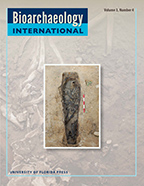Social Status and Its Relationship to Non-specific Stress at Late Iron Age Non Ban Jak, Northeast Thailand
Main Article Content
Abstract
The rise of social inequality is a key development in human history and is linked to deteriorating health. These associated health impacts are poorly understood for Iron Age (420 B.C.–A.D. 500) northeast Thailand. To clarify this issue we investigate whether social status differences influence non-specific stress at the site of Non Ban Jak (A.D. 300–800), which comprises two separate burial mounds. These mounds are thought to represent the neighborhoods of two distinct social groups at the site. Quantitative analyses were used to explore differences in grave goods among the adults of Non Ban Jak (N = 47). Long bone lengths, ages at death, and linear enamel hypoplasia (LEH) were examined to explore differences in non-specific stress on the basis of age, sex, burial mound, and mortuary phase. Results demonstrated that older adults of both sexes, males of all ages, and west mound individuals received greater grave good quantities and may therefore have been of higher social status. West mound individuals were taller and had a lower prevalence of LEH compared to those from the east mound. Although female LEH prevalence and mortality were reduced relative to males, decreasing stature over time and high neonatal mortality indicated greater female stress. Lower-status individuals may therefore have suffered increased stress relative to those of higher status. Artifactual and epigraphic evidence supports the suggestion of sex- and class-based status differences at Non Ban Jak, legitimized and perpetuated through the adoption of residential burial and new religious ideologies.
การปรากฎขึ้นของความไม่เท่าเทียมทางสังคมเป็นพัฒนาการสำคัญอย่างหนึ่งในประวัติศาสตร์มนุษยชาติและเชื่อมโยงกับสุขภาพที่เสื่อมลง ความรู้ความเข้าใจเกี่ยวกับสุขภาวะที่เกี่ยวเนื่องกับความไม่เท่าเทียมทางสังคมในสมัยเหล็ก (ประมาณ ๒,๔๐๐ – ๑,๕๐๐ ปีมาแล้ว) ในภาคตะวันออกเฉียงเหนือนี้ยังมีน้อย ดังนั้น เพื่อสร้างความเข้าใจให้ชัดเจนในเรื่องนี้ เราจึงได้ศึกษาตรวจสอบว่าความแตกต่างด้านสถานะทางสังคมมีอิทธิพลต่อความตึงเครียดหรือไม่ ทั้งนี้ เราใช้หลักฐานทางโบราณคดีจากแหล่งโบราณคดีโนนบ้านจาก (กำหนดอายุระหว่าง ๒,๓๐๐ – ๑,๒๐๐ ปีมาแล้ว) ซึ่งมีเนินหลุมฝังศพ ๒ เนิน เราเชื่อว่าเนินดินหลุมฝังศพทั้งสองเนินนี้เป็นแหล่งฝังศพของกลุ่มคน ๒ กลุ่มที่เป็นเพื่อนบ้านกันหรือมีความใกล้ชิดทางสังคม เราใช้วิธีการวิเคราะห์เชิงปริมาณในการศึกษาตรวจสอบความแตกต่างของวัตถุอุทิศที่พบร่วมกับหลุมฝังศพของคนในวัยที่เป็นผู้ใหญ่ นอกจากนี้ เรายังวิเคราะห์ความยาวของกระดูกแขน-ขา อายุเมื่อตาย และการเสื่อมผุของเคลือบฟัน เพื่อตรวจสอบระดับความแตกต่างของความตึงเครียดตามเพศ อายุ/วัย กลุ่มสังคม และช่วงเวลา ผลการศึกษาพบว่าผู้ใหญ่วัยสูงอายุทั้งเพศหญิงและชาย ผู้ชายทุกวัย และกลุ่มคนจากเนินฝังศพด้านตะวันตกมีจำนวนวัตถุอุทิศมากกว่ากลุ่มคนจากเนินฝังศพทางตะวันออก และดังนั้นคนที่ถูกฝังในเนินดินฝังสพทางตะวันตกอาจจะมีสถานภาพสูงกว่าคนที่ถูกฝังในเนินดินหลุมฝังศพทางตะวันออก คนที่ถูกฝังในเนินดินหลุมฝังศพทางตะวันตกมีร่างกายที่สูงกว่าและมีการเสื่อมผุของเคลือบฟันน้อยกว่าคนที่ฝังที่เนินดินทางตะวันออก และแม้ว่าการเสื่อมผุของเคลือบฟันและอัตราการเสียชีวิตของผู้หญิงลดลงเมื่อเปรียบเทียบกับผู้ชาย แต่ผู้หญิงก็มีส่วนสูงเฉลี่ยลดลง และมีอัตราการเสียชีวิตของทารกในครรภ์สูงขึ้นตามช่วงเวลาซึ่งอาจจะแสดงว่าผู้หญิงมีชีวิตความตึงเครียด และคนที่มีสถานภาพทางสังคมต่ำก็มีความตึงเครียดมากกว่าคนที่มีสภาพทางสังคมที่สูงด้วย หลักฐานประเภทโบราณวัตถุและจารึกโบราณสนับสนุนว่าความแตกต่างทางสถานภาพทางสังคมและเพศที่แหล่งโบราณคดีโนนบ้านจากเกิดขึ้นและดำรงอยู่ดังจะสะท้อนให้เห็นจากการฝังศพในที่อยู่อาศัยและการเข้ามาของระบบความเชื่อทางศาสนาอันใหม่

